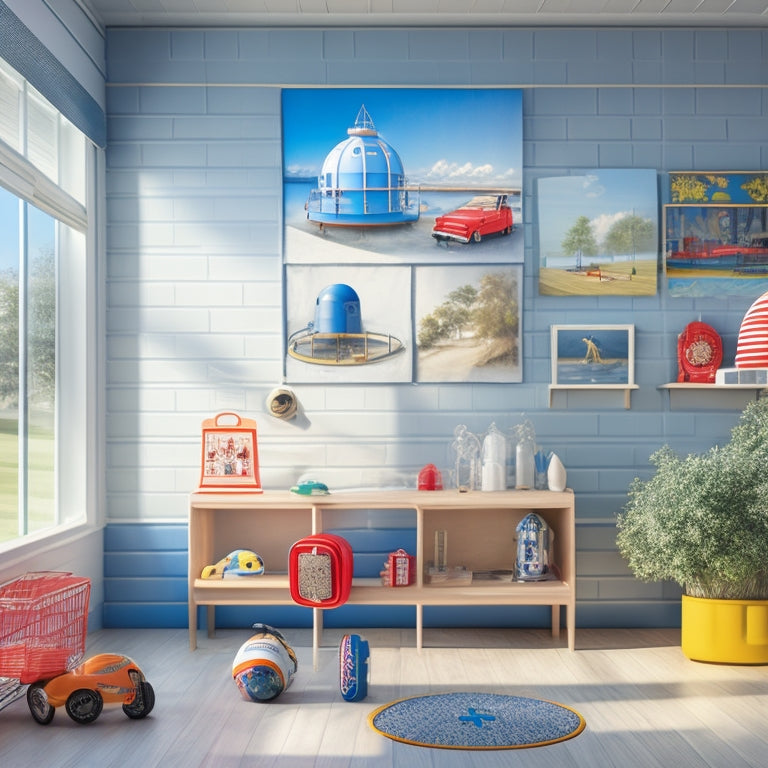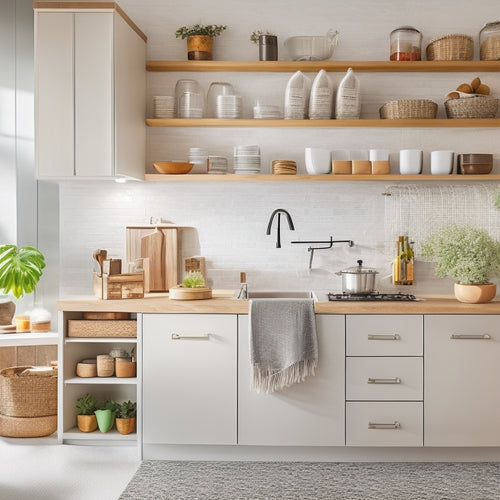
Ensuring Safety: Guidelines for Indoor and Outdoor Environments
Share
Ensuring safety in indoor and outdoor environments requires a thorough approach. Indoors, alarms on refrigerators, safety standards for climbers, and child-proofing measures are vital. Outdoor play areas need enclosures, self-closing gates, and regular maintenance of equipment. Conducting regular inspections and checking compliance with safety regulations are indispensable. Additionally, safe food and nutrition practices, health and hygiene requirements, and effective design and equipment all contribute to a safe environment. By covering these bases, organizations can create spaces where individuals can thrive. To create a truly safe environment, it's imperative to delve into every aspect of safety in depth.
Key Takeaways
• Implement indoor safety measures, including alarms on refrigerators, child proofing, and weekly visual inspections for furniture hazards.
• Ensure outdoor environment safety with enclosures, self-closing gates, and regular maintenance of play equipment.
• Conduct regular inspections to identify potential hazards and ensure compliance with safety regulations.
• Develop a written meal plan and implement safe food handling practices to prevent cross-contamination.
• Establish effective handwashing techniques and regular cleaning schedules to maintain hygiene and prevent contagious diseases.
Indoor Safety Essentials
Ensuring a safe indoor environment is essential for the well-being of children. This requires careful attention to details such as alarm or latch installation on refrigerators and adherence to safety standards for indoor climbers.
Effective child proofing measures, including the avoidance of bucket-style tables, are pivotal in preventing accidents. Supervision techniques, such as weekly visual inspections for furniture hazards, are also crucial in identifying potential risks.
Providers must guarantee compliance with safety standards for indoor equipment, including approval processes for homemade structures and repair of play equipment following manufacturer's instructions.
Outdoor Environment Safety
Providers must establish a secure outdoor environment by enclosing playgrounds within fences, barriers, or identified boundaries to prevent children from accessing nearby streets or other hazardous areas. This guarantees playground supervision and implements safety measures to prevent accidents.
| Outdoor Environment Safety | Guidelines |
|---|---|
| Playground Enclosure | Fences, barriers, or identified boundaries |
| Gate Requirements | Self-closing, self-latching gates with a minimum height of 48 inches |
| Outdoor Play Equipment | Regular maintenance and inspection for damage |
| Shaded Structures | Provided for outdoor spaces to prevent heat-related injuries |
Providers should also make certain that outdoor play equipment is well-maintained and regularly inspected for damage. Shaded structures should be provided for outdoor spaces to prevent heat-related injuries. By following these guidelines, providers can create a safe and healthy outdoor environment for children to play and learn.
Ensuring Compliance and Inspections
What steps must be taken to guarantee that indoor and outdoor environments meet the necessary safety standards and regulations?
Ensuring compliance and conducting regular inspections are vital to prevent hazards and ensure a safe environment for children. Inspection procedures must be in place to check for compliance with safety regulations, such as the 75 sq. ft. requirement for outdoor play areas and CPSC guidelines for equipment surfaces.
Compliance checks should also focus on gate locking mechanisms, emergency exits, and flooring and moisture resistance standards. Hazard prevention is key, and regular inspections can identify potential hazards before they become a safety risk.
Safe Food and Nutrition Practices
In addition to maintaining a safe physical environment, childcare providers must also prioritize safe food and nutrition practices to prevent hazards and establish a healthy environment for children. Meal planning, cleanliness, and nutrition education are essential components of a safe food environment. Providers should develop a written meal plan that considers children's dietary needs and allergies. Cleanliness is critical, and providers must guarantee that food preparation areas are sanitized regularly. Nutrition education is also important, and providers should educate children on healthy eating habits.
| Practice | Guideline | Rationale |
|---|---|---|
| Meal Planning | Develop a written meal plan | Ensure children's dietary needs are met |
| Cleanliness | Sanitize food prep areas regularly | Prevent bacterial growth and contamination |
| Nutrition Education | Educate children on healthy eating habits | Promote healthy development and well-being |
| Food Handling | Handle food safely to prevent cross-contamination | Prevent foodborne illnesses |
| Sanitation | Clean and sanitize utensils and equipment | Prevent bacterial growth and contamination |
Health and Hygiene Requirements
Establishing and maintaining a clean and hygienic environment is crucial for preventing the spread of illnesses and infections in childcare settings. This requires implementing effective handwashing techniques and hygiene protocols to minimize the risk of contamination. Providers should guarantee that handwashing stations are easily accessible and equipped with soap, water, and single-use towels.
Hand sanitizers can be used as an additional measure, but not as a replacement for handwashing. Additionally, surfaces and equipment should be regularly cleaned and disinfected to prevent the spread of germs. A cleaning schedule should be established to maintain a hygienic environment, and providers should be aware of protocols for handling contagious diseases and lice infestations.
Safety in Design and Equipment
Providers must guarantee that the design and equipment in both indoor and outdoor environments meet safety standards to prevent injuries and promote a secure learning space. This involves ensuring that all equipment is well-maintained, and regular inspections are conducted to identify potential hazards. Childproofing measures, such as installing safety latches on refrigerators, are also essential. Playground equipment must meet specific safety guidelines, and providers should prioritize design safety when selecting equipment.
| Safety Measure | Description |
| Equipment Maintenance | Regular inspections to identify potential hazards |
| Childproofing | Installing safety latches on refrigerators and other equipment |
| Playground Equipment Safety | Meeting specific safety guidelines for outdoor play equipment |
| Design Safety | Prioritizing safety in equipment design and selection |
Preventing Hazards and Injuries
They must implement safety guidelines and protocols to prevent hazards and injuries in both indoor and outdoor environments, establishing a secure learning space for children.
Childproofing techniques, such as installing alarms or latches on refrigerators, are essential for injury prevention.
Conducting regular hazard assessments helps identify potential risks and implement safety measures to mitigate them. For instance, weekly visual inspections can detect furniture hazards, while approving homemade indoor equipment ensures compliance with safety standards.
Frequently Asked Questions
How Often Should I Conduct a Safety Assessment of Indoor Structures?
As a beacon of safety, she conducts a weekly visual inspection of indoor structures, scrutinizing for hazards and ensuring structural integrity, thereby mitigating risks through thorough risk assessments and prompt repairs.
Can I Use a Temporary Fence for Outdoor Play Areas?
She guarantees play boundaries are secure by selecting fence materials that meet safety standards, considering durability, and verifying compliance with regulations, such as the 48-inch minimum height requirement, for temporary outdoor play area fences.
Are There Any Exceptions to the 48-Inch Fence Height Requirement?
"Cutting corners" isn't an option when it comes to fence height; however, she checks local regulations, as some areas may permit alternative fence materials or structures that deviate from the standard 48-inch requirement.
Can I Use Homemade Cleaning Products in the Food Prep Area?
She avoids using homemade cleaning products in the food prep area, opting for natural alternatives and effective substitutes that meet regulatory standards, ensuring a safe and sanitary environment for children.
What Is the Protocol for Reporting Safety Incidents to Licensing Authorities?
As a sentinel stands watch, ever vigilant for potential dangers, providers must swiftly report safety incidents to licensing authorities, following a structured Incident Response protocol, ensuring timely Authority Notification and swift corrective action.
Related Posts
-

Streamlined Kitchen Sink Organization Solution
A streamlined kitchen sink organization solution must balance functionality with aesthetics. A well-designed system s...
-

Create Your Own Kitchen Countertop Organizer System
To create your own kitchen countertop organizer system, start by evaluating your available counter space, identifying...

